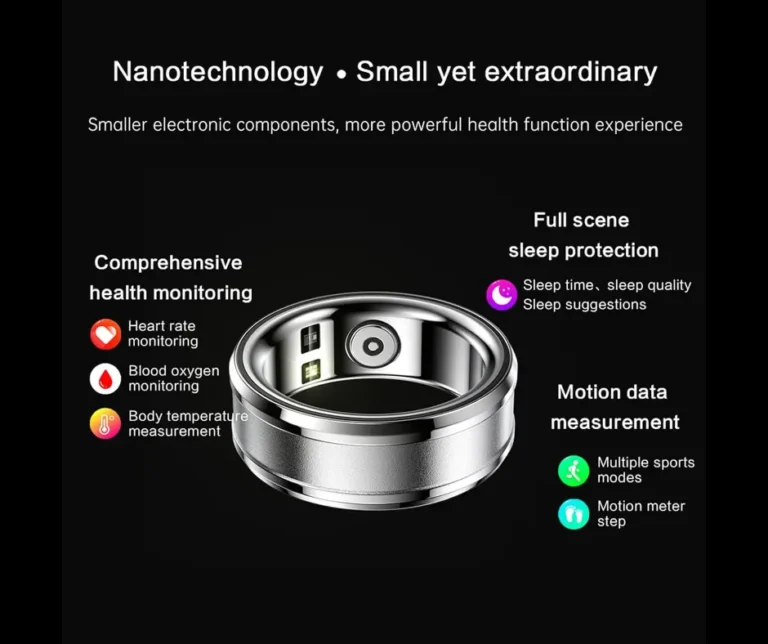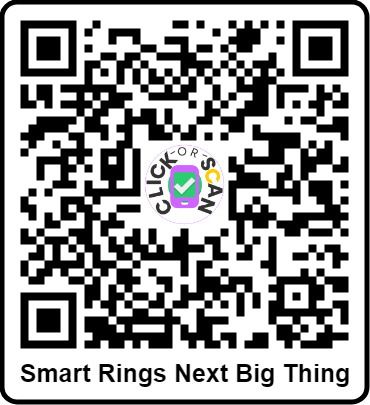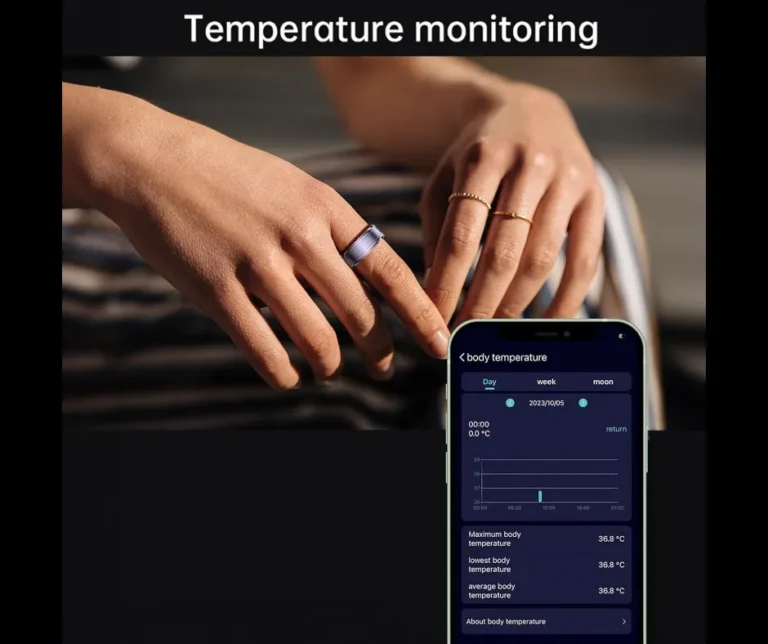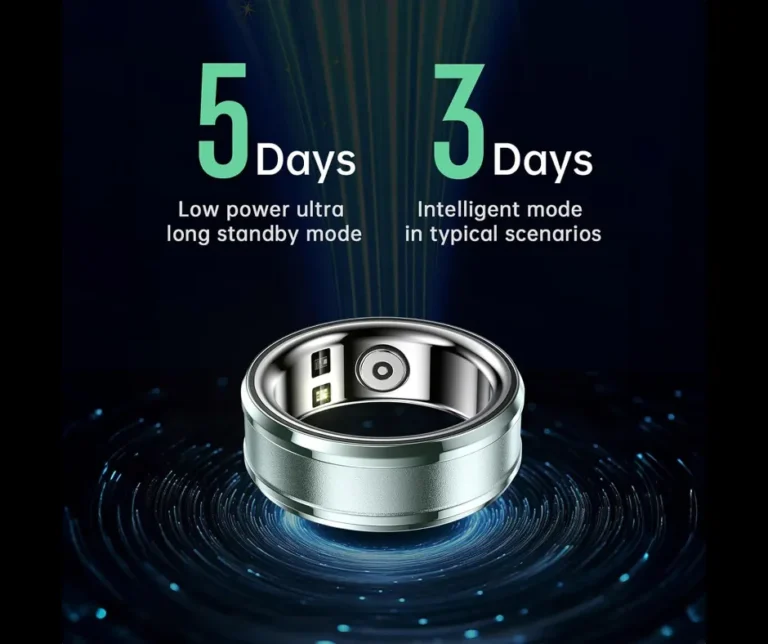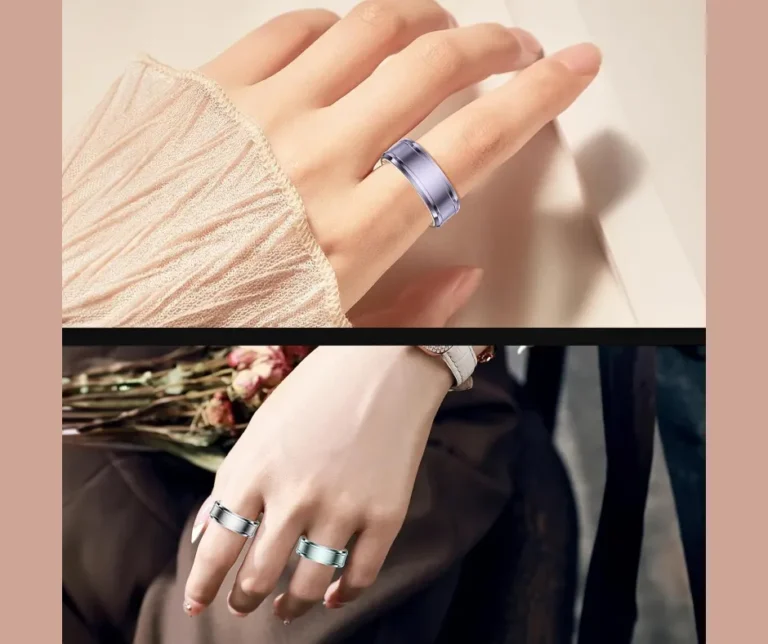Smart Rings Next Big Thing in Health and Wellness
In a world where wearable technology continues to revolutionize the health and wellness industry, smart rings have emerged as the next frontier in health tracking.
This article will demonstrate Why Smart Rings Next Big Thing in Health and Wellness
These sleek and sophisticated devices are designed to monitor vital signs and provide valuable data for overall health management.
As the demand for convenient and portable health tracking solutions grows, the impact of smart rings on health and wellness is being increasingly explored and recognized.
Wearable devices have been on the rise, offering individuals the opportunity to track their fitness, monitor their sleep, and keep an eye on their heart rate throughout the day. Smart rings, equipped with advanced sensors and cutting-edge technology, take health tracking to a new level by providing valuable insights and real-time data for users.
The functionality and key features of smart rings play a crucial role in elevating the health and wellness experience for individuals seeking to proactively manage their well-being.
In this article, we will delve into the importance of health tracking and the advantages of incorporating smart rings into daily health routines.
Moreover, we will explore the potential of smart rings in shaping the future of health and wellness, including their possible integration with fitness apps and health platforms, as well as their implications for cardiovascular and menstrual health monitoring.
The Rise of Wearable Devices
The wearable technology market has seen impressive growth, with a valuation of USD 61.30 billion in 2022 and forecasts predicting a robust CAGR of 14.6% through to 2030. This expansion is partly driven by health-conscious individuals, particularly in the age bracket of 35 to 54 years in the United States, where 40% of this demographic have adopted wearable devices like smartwatches and fitness trackers. North America is at the forefront of this trend, holding a commanding 40.7% revenue share in the global market during 2022.
Among wearable tech, smart rings stand out, with the global market for these sleek devices skyrocketing from USD 20 million in 2022 to an anticipated USD 197.03 million by 2030. These rings represent the cutting-edge intersection of style and utility, redefining the wearable landscape. Here’s a quick glimpse at the surge of wearable devices:
| Global Market Valuation 2022 | Projected Valuation by 2030 | CAGR |
|---|---|---|
| $61.30 billion | Not stipulated | 14.6% |
| $20 million (Smart Rings) | $197.03 million | Not stipulated |
Key Drivers for Market Growth:
- Health awareness among adults (35-54 age group)
- Dominance in the North American market
- Rise of smart rings as both practical and stylish tech accessories.
Smart Rings: The Next Frontier in Health Tracking
In a world where we relentlessly pursue the optimization of our health and well-being, smart rings are emerging as pivotal players in the health tracking arena. These chic, wearable devices are more than mere fashion statements—they are transforming the way we engage with personal health data in our daily lives.
Smart rings differ from traditional wearable tech through their discrete size, making health tracking an almost invisible part of a user’s day. Discreet by design and significant in functionality, they collate a wealth of information pertaining to vital health stats. We’re talking about a device barely noticeable on the finger that can monitor heart rate, reflect sleep quality, and even log calorie burn with astonishing accuracy.
Imagine the potential of constant health monitoring without the constant feel of something strapped to your wrist—this is what gives smart rings their edge. Their ergonomics facilitate continuous, comfortable wear, and with battery life far surpassing that of many smartwatches, user interruption is kept minimal. This seamless integration into daily routines means that users are more likely to consistently track their fitness and health metrics, lending to better, long-term outcomes for their well-being.
But beyond the convenience, these rings are fast becoming a lynchpin in the preventative measures of modern healthcare—deployed for patient monitoring and early disease detection with innovational precision. From tracking heart rate variability—a key indicator of cardiovascular health—to observing patterns in sleep that signal broader health issues, smart rings have proven their prowess time and again.
The market for these devices is booming. Analysts project their prevalence only to escalate, as they marry meticulous health monitoring capabilities with an unobtrusive presence. They grant the everyday individual the ability to keep their finger literally on the pulse of their health trends, enabling informed decisions and proactive measures towards a healthier life.
Understanding the Functionality of Smart Rings
At their core, smart rings are miniature wearable computers. Sized to fit snugly on a finger, they house mobile components, like NFC chips and biometric sensors, effectively making them minuscule powerhouses of health data collection. Unlike other wearables with screens, smart rings primarily function through connectivity with other smart devices, such as smartphones, serving as subtle companions to these larger gadgets.
Through this interconnectivity, smart rings act as vigilant sentinels, capturing every heartbeat, counting steps, and even monitoring menstrual cycles. They measure blood oxygen levels and body temperature, crucial data points for understanding one’s own health. Every piece of information gets seamlessly transmitted to a companion app, where users can track their progress, analyze health patterns, and set realistic goals to maintain or improve health outcomes.
The ingenuity behind smart rings doesn’t end at basic tracking; they offer a deeper dive into one’s health status. For instance, modern smart rings have the capability to detect heart rate variability—a marker of stress levels and heart health—allowing users to tweak their lifestyles for improved cardiovascular health. Moreover, in this age where understanding and managing stress can be as critical as physical fitness, several smart rings come equipped with tools designed to aid in mental well-being.
Key Features of Smart Rings for Health Monitoring
Smart rings have come to the forefront because of a range of features geared towards maintaining a healthy balance in users’ lives. Here are the key features that set them apart from other wearable devices:
- Holistic Health Tracking: These rings go beyond basic step counting. They offer comprehensive monitoring of daily activities, sleep patterns, calorie burn, and even provide valuable insights into menstrual health, making every health aspect trackable.
- Discretion and Comfort: One of the smart rings’ most appealing attributes is their sleek design, which meshes with the user’s style while being ergonomically crafted for long-wear comfort.
- Advanced Sleep Analysis: Sleep quality is integral to health, and smart rings offer detailed sleep tracking, evaluating duration and disturbances to foster better sleep hygiene practices.
- Heart Rate Monitoring: Continuous and precise heart rate monitoring is pivotal, offering a window into the user’s daily cardiovascular functioning and overall fitness levels.
- Battery Life: Unlike many wearables, smart rings have exceptionally long battery life, reducing the hassle of frequent charges and ensuring consistent monitoring.
- App Integration: Paired with comprehensive companion apps, users can make sense of the collected data to gain insights, set targets, and monitor health trends over time.
- Affordability and Accessibility: Strategically priced, smart rings present a cost-effective alternative for personal health tracking, democratizing access to technology that can guide users toward better health.
Smart rings encapsulate a tech evolution that enhances our health and harmonizes with our lifestyle. With wearable devices nestling into our daily narratives, it’s not hard to see why smart rings are staking their claim as the next big thing in health and wellness. They promise to furnish users with a discreet, yet effective means to keep health in check, granting new power in navigating personal wellbeing with an elegance that mirrors their sophisticated technology.
The Importance of Health Tracking
Health tracking has taken on a new level of significance in a world where individuals are increasingly focused on maintaining optimal health. With the prevalence of lifestyle-related diseases, having a personalized stream of health data at our fingertips can lead to early detection of potential health issues, prompt intervention, and better management of existing conditions. By keeping a consistent record of our daily activities, heart rate, sleep patterns, and other metrics, we empower ourselves with knowledge—knowledge about how our bodies react to different stimuli, how our lifestyle choices affect our well-being, and what changes could yield improvements.
Moreover, regular health tracking supports people in forming healthy habits, sticking to fitness goals, and understanding the intricate patterns of their sleep cycles—crucial elements for achieving a balanced and healthy lifestyle. It can also reveal alarming health trends, providing an opportunity to take preventive measures before serious complications arise. Notably, for those with chronic conditions like diabetes or cardiovascular disease, continuous monitoring of relevant health stats could mean the difference between stability and an emergency health event. In essence, health tracking is the cornerstone of proactive health management, standing as a guardian for our well-being in the fast-paced modern world.
How Wearable Devices Can Improve Overall Health
Wearable devices have revolutionized the way we can improve our overall health, serving not only as fitness companions but also as proactive guardians of our physical and mental well-being. By providing real-time notifications and reminders, these devices ensure that we remain active throughout the day, meet our hydration goals, and take breaks to manage stress effectively. Additionally, wearables give users the tools to set and track fitness objectives, encouraging them to push through boundaries and achieve new personal bests.
A significant benefit comes from the analysis of sleep quality—wearable devices can drastically improve our understanding of sleep patterns, allowing us to make adjustments for deeper and more rejuvenating rest. Devices that monitor stress levels guide users through breathing exercises or mindfulness sessions, promoting mental health. For those managing chronic conditions, the consistent data stream can lead to personalized healthcare recommendations and adjustments from healthcare providers. The connection between wearable devices and health is clear; by staying informed about our body’s signals, we are more equipped to make choices that enhance our overall health and longevity.
The Role of Smart Rings in Monitoring Vital Signs
Smart rings have carved a unique niche in the wearable tech space, particularly when it comes to monitoring vital signs as part of an individual’s health regime. Unlike bulkier wrist-worn devices, smart rings take subtlety and convenience to new heights. They sit unassumingly on the finger—the location closest to the heart—to deliver accurate data on vital signs such as heart rate and heart rate variability. These readings are not only foundational for understanding heart health but also provide insights into stress levels, potentially leading to lifestyle modifications conducive to cardiovascular health.
Integrating cutting-edge sensors and algorithms, smart rings offer a seamless and less intrusive means to keep tabs on one’s physical state throughout the day and night. They continuously capture data that allows users to witness patterns and receive alerts, all with the goal of maintaining or improving health benchmarks. Innovations in the field suggest that smart rings will soon be able to monitor even more complex health metrics, such as blood pressure and glucose levels, providing comprehensive health management right from one’s fingertip. The full spectrum of monitoring capabilities, along with the ring’s discreet nature, makes it not only a powerful tool for early disease detection but also a fashionable accessory aligned with the rhythm of everyday life.
Advantages of Smart Rings
Advantages of Smart Rings abound, from their snug fit to their cutting-edge functionality. These wearables combine style, convenience, and versatility, setting them apart from larger, more conspicuous devices like smartwatches and fitness trackers.
Firstly, the sleek designs of smart rings are often stylish and customizable, reflecting a user’s personal style with a variety of shapes, sizes, and colors. They blend seamlessly into one’s day, ensuring the monitoring of health and wellness doesn’t compromise fashion sense.
Another key feature that puts smart rings ahead is their non-intrusive nature. Designed to feel natural on the hand, they minimize interference with everyday activities—something that bulkier devices can’t promise. Users can go about their days with scarcely a notice to the device on their finger, highlighting the rings’ comfort and subtlety.
Furthermore, these modern marvels come armed with contactless payment capabilities. With a simple gesture, you can check out at the store, thanks to NFC technology. Fast, secure, and right at your fingertips—literally—making transactions is rendered more convenient than ever.
Smart rings also boast low maintenance requirements and extended battery life since many can operate in airplane mode or offline. Infrequent charging means these gadgets are always on hand to capture valuable data, ensuring that users are not often sidelined by the need to power up their device.
Lastly, the integration possibilities are expansive with smart rings. They can act as remotes to control smart home devices, manage calls and texts, and even cue up your favorite playlist, providing utility that permeates multiple aspects of daily life.
Convenience and Portability of Smart Rings
The convenience and portability of smart rings are unrivaled in the landscape of wearable technology. Their small size and lightweight build mean they can be kept on during all daily tasks—from the office to the gym, to the bed at night. This round-the-clock wearability ensures that no health stat goes unrecorded.
Without the need for frequent charging, they prove to be ideal companions for the busy individual. Many models have extended battery life, lessening the need for constant power and maintenance, which can disrupt the flow of daily life and lead to missed data.
Moreover, their ability to operate independently of a phone, in airplane or offline mode, allows for uninterrupted tracking while ensuring privacy and reduced electromagnetic exposure. The portability extends to situations where smartphone use is restricted, ensuring that the tracking of health metrics continues without hindrance.
Enhanced Health and Fitness Tracking Capabilities
Smart rings are at the forefront of the health and wellness movement, offering enhanced health and fitness tracking capabilities that are as insightful as they are convenient. These devices sync in real-time with smartphones, providing users with immediate feedback on heart rate, sleep patterns, steps taken, and calories burned.
They have morphed into our personal health assistants, offering features like real-time stress monitoring with personalized breathing exercises to help manage day-to-day pressures. Further, they are equipped with advanced sensors that diligently collect data on various vital signs, translating them into valuable insights for users.
Sleep-tracking functionality is particularly notable, capturing details on sleep duration and quality. This allows users to hone in on sleep disturbances and empowers them to make lifestyle adjustments for better rest. The comprehensive tracking extends throughout the day too, with the ability to quantify calorie intake and expenditure, providing a holistic view of one’s health.
Wearing these rings 24/7 means data sets are robust, offering a continuous, accurate assessment of well-being over time. This constant data flow enables users to gauge their health trends, make informed decisions, and, if necessary, share these findings with healthcare professionals to tailor their health interventions.
In conclusion, smart rings are not merely gadgets; they are powerful tools for managing daily health, offering a level of convenience, style, and deep health tracking capabilities that make them poised to be the next big thing in the health and wellness sphere.
Understanding Health Trends with Smart Rings
Smart rings stand out as a trend-setting force in the health and wellness technology arena, largely due to their exceptional ability to capture and analyze health data. By monitoring vital signs such as heart rate, tracking sleep patterns religiously, and providing metrics on daily activities, these discreet devices offer a wealth of information, unlocking understanding of both immediate and long-term health trends.
The continuous data collection afforded by smart rings, which can be worn seamlessly 24 hours a day, ensures that every heartbeat, every restless night, and every step taken contributes to a detailed health profile, offering a meticulous chronicle of an individual’s wellness journey. As these devices are designed to be worn on the finger closest to the heart, the accuracy of the vital sign measurements they provide is remarkably high. Consequently, trends that may be imperceptible on a day-to-day basis are brought to light, granting users the potential to preempt health challenges and adjust their habits proactively.
Analyzing Data from Smart Rings for Valuable Insights
The wealth of data produced by smart rings goes beyond mere statistics; with sophisticated algorithms, this information is transformed into actionable insights. When smart ring apps interlace with existing health and fitness applications, they compose a comprehensive health mosaic, offering the wearer a full picture of their wellbeing.
One of the profound strengths of smart rings is their ability to distill complex biometric data into personalized insights. Instead of overwhelming users with raw numbers and graphs, these insights are often served up as easy-to-understand recommendations and health scores. For instance, minute variations in sleep quality or heart rate variability might suggest stress or the onset of sickness, prompting the ring’s companion app to signal the need for rest or a checkup.
The Impact of Smart Ring Data on Daily Health Outcomes
When it comes to enhancing daily health outcomes, the impact of smart rings and the data they compile cannot be overstated. Doctors and medical professionals are beginning to value the depth of information available from these devices, as they can reveal patterns indicative of potential health risks. This opens the door for preventive medicine, where interventions can occur before conditions worsen.
For the wearer, the immediacy of feedback provided by smart rings has an empowering effect. Cumulative health stats guide users to adopt healthier habits, be it refining sleep hygiene, optimizing exercise routines, or managing stress more effectively. With their fingers on the pulse of their own data, individuals not only understand their current state of health but are also equipped to track improvement over time, thereby making healthier choices that mould their future wellbeing.
In essence, smart rings give individuals back control over their health narrative, transforming daily choices into outcomes that shape a healthier, more informed life. As adoption grows and technology evolves, smart rings are set to redefine personalized healthcare, signaling a future where our smallest actions are informed by a deep understanding of our own unique health rhythms.
The Future of Smart Rings in Health and Wellness
The trajectory of smart rings in the health and wellness sphere is marked by groundbreaking innovation and a shift toward more integrated, precise, and personal health management. With an increasing array of features – including heart rate monitoring, sleep tracking, and even calorie intake measurement – these wearable devices evolve beyond basic fitness tracking to encompass comprehensive well-being monitoring tools. They empower wearers with immediate insights into their physical state, enabling informed decisions and fostering a proactive mindset toward health.
One of the most significant developments in smart ring technology lies in its detailed data acquisition capabilities, offering valuable information to healthcare providers. This can lead to identifying patients who may be at risk of developing certain conditions, facilitating early intervention strategies. Through integration with health and fitness apps, smart rings also contribute to a more holistic health management approach, combining data from various sources for a complete wellness overview. As technology advances, the promise of smart rings extends to potentially revolutionizing healthcare practices, providing personalized care recommendations, and strengthening preventive medicine frameworks.
The appeal of smart rings is amplified by their ergonomic comfort, discreet form, and multiplicity of advanced functions, setting the stage for them to become indispensable to our daily lives. Moving forward, as wearable tech becomes more sophisticated and user-friendly, smart rings are anticipated to become a central feature in the ongoing evolution of personalized health care.
Potential for Integration with Fitness Apps and Health Platforms
Smart rings seamlessly integrate with existing fitness apps and health platforms, vastly enriching the user experience by consolidating multiple sources of health information. By doing so, they facilitate a comprehensive approach to tracking and managing health, enabling users to view their health status in an all-inclusive context. The integration with other health platforms allows for continuous synchronization with various health wearables and medical devices, ensuring that users have the most current data at their fingertips.
With AI-powered technology, smart rings can analyze long-term data and provide personalized coaching and health recommendations. This tailored advice is drawn from the user’s unique health trends and can promote healthier lifestyle choices. Additionally, many smart ring apps incentivize user engagement through a rewards system. Users can earn badges, points, or even discounts by maintaining healthy habits and consistent app usage, making health monitoring both rewarding and engaging.
Customizable settings are another key aspect of these devices, allowing users to adjust notification preferences and health tracking options to suit individual needs and preferences. As smart rings continue to integrate with more health apps and platforms, they will increasingly streamline personal health management, offering a unified, efficient, and personalized health experience.
The Implications for Cardiovascular and Menstrual Health Monitoring
Smart rings are paving the way for innovative monitoring capabilities, particularly in cardiovascular and menstrual health. These rings can capture detailed bioimpedance data, which can offer insightful AI-powered predictions. This is especially beneficial for cardiovascular health monitoring, where early detection of issues can be life-saving. For expectant mothers, tracking fetal heart rate and maternal sleep patterns can provide a means for early detection of cardiovascular irregularities while also offering much-needed reassurance.
In the realm of menstrual health, specialized smart rings like the Evie Ring provide comprehensive tracking and predictive insights. They can monitor aspects such as menstrual cycle phases, mood fluctuations, sleep quality, and physical activity, all of which contribute to a holistic perspective on a woman’s health. The Ultrahuman Ring Air offers at-a-glance health data vital for understanding one’s cycle and optimizing wellness routines accordingly.
Furthermore, the ability of these apps to analyze health data and provide personalized fertility and menstrual cycle tracking empowers women with a heightened awareness of their bodies. It supports them in making informed decisions regarding their menstrual and overall health. The Evie Ring stands out by offering this array of insights without necessitating additional subscriptions or memberships, ensuring that vital health information remains accessible to all women. As smart rings grow more advanced, the implications for improved health outcomes in cardiovascular and menstrual monitoring are both vast and encouraging, showing great promise for the future of women’s health care.

